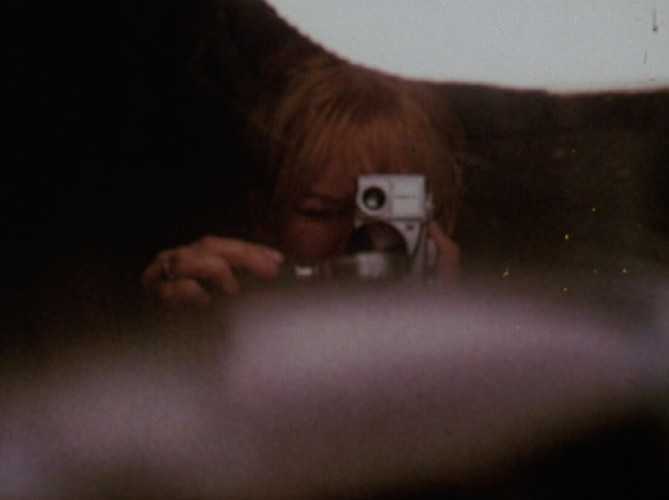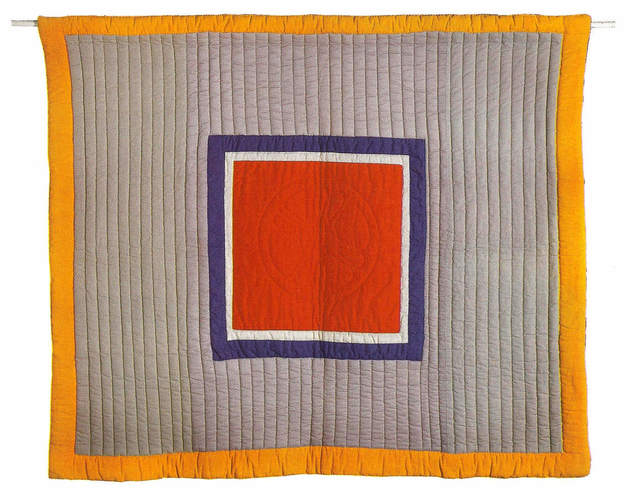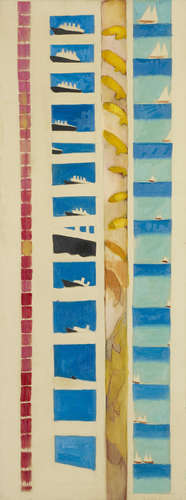During the 1960s, Joyce Wieland (1930–1998) sustained her visual art practice while branching out into experimental film. The exploration of cinematic framing, sequentiality, and narrative momentum was not limited to her actual filmmaking, though. She also set out to transfer these aspects of cinematic style to her visual art practice, making a range of paintings, assemblages, and fabric objects that in some way mimic or evoke films.

16mm film, colour, sound, 13:30 min., National Gallery of Canada, Ottawa
In 1971 the influential American film critic Andrew Sarris announced that “the talented Canadian Joyce Wieland leads the contingent of women film-makers in the experimental, abstract, poetic, avant-garde, underground categories.” Wieland achieved this reputation as she showed her films alongside those by other artists grouped around New York’s Film-Makers Cooperative, including Jonas Mekas (b.1922), Hollis Frampton (1936–1984), Shirley Clarke (1919–1997), the Kuchar brothers (Mike, b.1942; George, 1942–2011), Jack Smith (1932–1989), Flo Jacobs (b.1941) and Ken Jacobs (b.1933), and her husband, Michael Snow (b.1928). Many of the films produced by these artists are short. They provide neither heroes nor romantic leads for the audience to emotionally identify with, and they frequently dispense with a narrative line.

Quilted cloth, 138 x 160 cm, private collection
Wieland has often been associated with the Structural film movement, whose practitioners concentrated on the material properties of film, projection, light, and camera movement, while generally avoiding narrative completely. Wieland was never a perfect fit with the Structural school, though, and the term “underground film” is perhaps as appropriate, in that films from this genre and era are often rooted in subcultural or countercultural social groups. Wieland was inspired by Jack Smith’s cheaply made Flaming Creatures, 1963, a fantastical vision of cross-dressing made by Smith and his friends. Engaging with both underground and Structural approaches to filmmaking, Wieland’s films unravel the material qualities of the cinematic image, while also introducing storylines related to politics, patriotism, sexuality, embodiment, and other themes of interest to the counterculture.

Oil on canvas, 106.7 x 40.6 cm, Art Gallery of Ontario, Toronto
While Wieland was making films—such as Patriotism II, 1964; Water Sark, 1965; Hand Tinting, 1967; and Sailboat, 1967—she was also creating paintings, plastic assemblages, and quilts using diverse materials that transform and adapt cinematic language and technique. From 1963 onward many of her paintings are divided into frames that are read sequentially, implying both movement and narrative progression, even when the storyline is as rudimentary as the plight of a sinking ship, as in Boat Tragedy, 1964, or a romantic kiss, as in First Integrated Film with a Short on Sailing, 1963. These paintings often include cinematic devices such as frame-by-frame advances to a close-up, as if in a deconstructed zoom, and sudden shifts of perspective.

Oil on canvas, 77 x 30 cm, collection of Dennis Reid
In 1966–67 Wieland made a series of soft hanging sculptures using plastic. These sculptures resemble vertical strips of film and are explicitly titled “film” or “movie,” as in Stuffed Movie, 1966. In the quilts she made in 1966, such as The Camera’s Eyes and Film Mandala, the familiar geometric aspect of traditional quilts now accommodates the square form of an old movie camera and the round shape of the lens.
-article-image.jpg)
Mixed media, 142.2 x 36.8 cm, Vancouver Art Gallery
The recurrence of cinematic motifs in Wieland’s art practice is a clear acknowledgement of the profound impact that movies had on all aspects of twentieth-century visual culture. By complementing her actual filmmaking with hybrid art forms that borrow aspects of cinematic experience, Wieland contributed to a new way of making art in the 1960s—between and across media.
This Essay is excerpted from Joyce Wieland: Life & Work by Johanne Sloan.
 Karen Tam’s Autumn Tigers
Bridging Past and Present: Invisible Made Visible
By Imogene L. Lim, PhD
Karen Tam’s Autumn Tigers
Bridging Past and Present: Invisible Made Visible
By Imogene L. Lim, PhD
 The Frontier Portraits of C.D. Hoy
A Chinese Canadian Photographer’s Tribute to His Community
By Faith Moosang
The Frontier Portraits of C.D. Hoy
A Chinese Canadian Photographer’s Tribute to His Community
By Faith Moosang
 Interrogating Identity
Suzy Lake explores the role of photography in shaping how we understand and see ourselves
By Erin Silver
Interrogating Identity
Suzy Lake explores the role of photography in shaping how we understand and see ourselves
By Erin Silver
 An Emboldened Artist
How Oviloo Tunnillie achieved rare international acclaim as an Inuit female sculptor
By Darlene Coward Wight
An Emboldened Artist
How Oviloo Tunnillie achieved rare international acclaim as an Inuit female sculptor
By Darlene Coward Wight
 Painting the Cultural Mosaic
William Kurelek traversed the country in a quest to capture its diverse inhabitants
By Andrew Kear
Painting the Cultural Mosaic
William Kurelek traversed the country in a quest to capture its diverse inhabitants
By Andrew Kear
 Domestic Discontent
Mary Pratt’s poetic scenes of home life are praised for their political edge
By Ray Cronin
Domestic Discontent
Mary Pratt’s poetic scenes of home life are praised for their political edge
By Ray Cronin
 A New Vision of the North
Annie Pootoogook’s art offers unprecedented insights into the contemporary Arctic
By Nancy G. Campbell
A New Vision of the North
Annie Pootoogook’s art offers unprecedented insights into the contemporary Arctic
By Nancy G. Campbell
 Meetings of Minds
Sorel Etrog found new ideas in collaborative work
By Alma Mikulinsky
Meetings of Minds
Sorel Etrog found new ideas in collaborative work
By Alma Mikulinsky
 Introducing Miss Chief
An excerpt from the ACI’s book “Revision and Resistance”
By Shirley Madill
Introducing Miss Chief
An excerpt from the ACI’s book “Revision and Resistance”
By Shirley Madill
 A Practice of Recovery
An excerpt from the ACI’s book “Revision and Resistance”
By Sasha Suda
A Practice of Recovery
An excerpt from the ACI’s book “Revision and Resistance”
By Sasha Suda
 Decolonizing History Painting
An excerpt from the ACI’s book “Revision and Resistance”
By Ruth B. Phillips and Mark Salber Phillips
Decolonizing History Painting
An excerpt from the ACI’s book “Revision and Resistance”
By Ruth B. Phillips and Mark Salber Phillips
 A Vision for the Future
An excerpt from the ACI’s book “Revision and Resistance”
By Nick Estes
A Vision for the Future
An excerpt from the ACI’s book “Revision and Resistance”
By Nick Estes
 Inside Kent Monkman’s Studio
An excerpt from the ACI’s book “Revision and Resistance”
By Jami C. Powell
Inside Kent Monkman’s Studio
An excerpt from the ACI’s book “Revision and Resistance”
By Jami C. Powell
 The Rule of Chance
Jean Paul Riopelle’s break with Automatism
By François-Marc Gagnon
The Rule of Chance
Jean Paul Riopelle’s break with Automatism
By François-Marc Gagnon
 From Taos to New York
Agnes Martin and the currents of American Art
By Christopher Régimbal
From Taos to New York
Agnes Martin and the currents of American Art
By Christopher Régimbal
 An Artist Blooms
Mary Hiester Reid’s floral aesthetics
By Andrea Terry
An Artist Blooms
Mary Hiester Reid’s floral aesthetics
By Andrea Terry
 The Patriotic Painter
Greg Curnoe’s Canada
By Judith Rodger
The Patriotic Painter
Greg Curnoe’s Canada
By Judith Rodger
 Walking, Stacking, Dancing
Françoise Sullivan’s conceptual 1970s
By Annie Gérin
Walking, Stacking, Dancing
Françoise Sullivan’s conceptual 1970s
By Annie Gérin
 The Extraordinary North
Tom Thomson’s diary of landscape
By David P. Silcox
The Extraordinary North
Tom Thomson’s diary of landscape
By David P. Silcox
 A Champion of Abstraction
Jock Macdonald sought a new expression in art
By Joyce Zemans
A Champion of Abstraction
Jock Macdonald sought a new expression in art
By Joyce Zemans